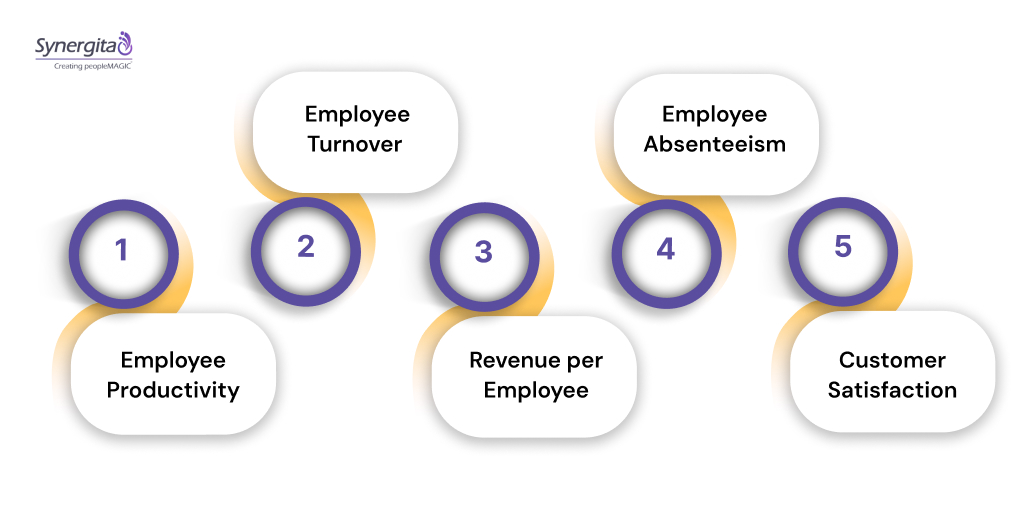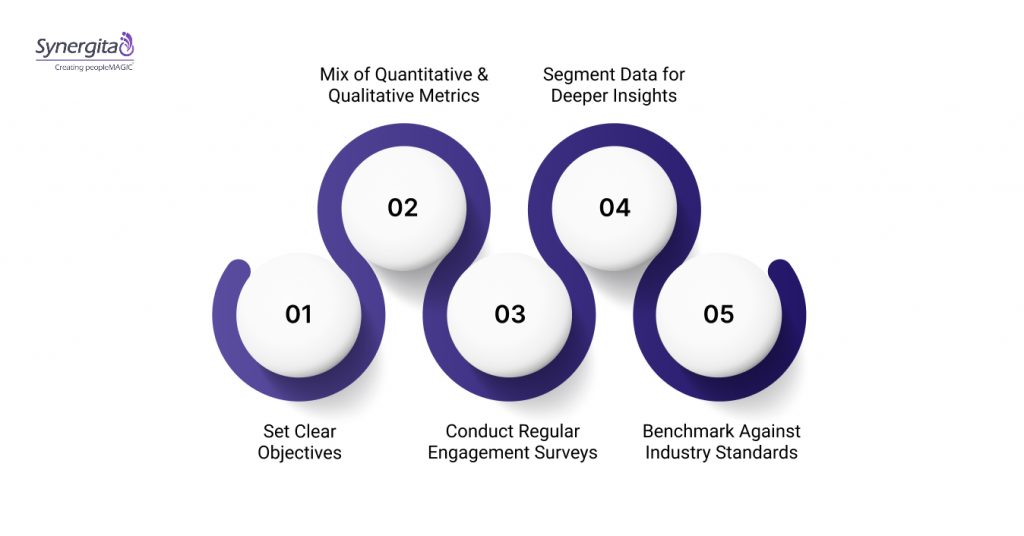Employee engagement has evolved from a mere perk to a powerful engine driving organizational success and long-term growth. In fact, the global share of fully engaged workers rose to 19% in 2024, up from its pandemic low of 14%.
That modest increase makes it clear: even small boosts in engagement can yield significant returns. This guide explores how to measure, maximize, and justify the employee engagement ROI so you can turn culture and connection into clear business value.
Quick Overview:
- Higher emotional investment leads to better performance and collaboration.
- Engaged employees stay longer and miss fewer workdays, lowering recruitment and replacement costs.
- Each 1% increase in engagement correlates with measurable sales growth and higher output.
- Employees who feel valued provide better service, improving loyalty and repeat business.
- Combining increased revenue and cost savings minus engagement program costs shows the financial impact of engagement initiatives.
What Is Employee Engagement?
At its core, employee engagement refers to how emotionally committed and invested employees are in their work and the organization’s mission. It’s more than just job satisfaction. It’s about employees feeling connected to their roles, motivated to contribute, and aligned with the company’s goals.
While many organizations try to boost motivation and channel it toward business success, few manage to do so effectively. That’s because engagement isn’t something that can be mandated. It’s a voluntary choice employees make every day when they show up to work.
To foster that choice, leaders must go beyond policies and perks. It takes a human-centered approach: nurturing talent, building an inclusive culture, and actively listening to employee feedback. When companies prioritize these efforts, they create an environment where engagement becomes the natural, chosen response.
Why Employee Engagement Matters To You?
Humans naturally seek meaningful, reciprocal relationships, and the workplace is no exception. When employees feel a genuine sense of connection, purpose, and belonging at work, they’re more motivated to commit to organizational goals and contribute beyond their basic responsibilities.
Engaged employees don’t just show up. They bring energy, creativity, and accountability to their roles. As a result, organizations with high engagement levels benefit from:
- Significantly higher productivity
- Stronger retention and lower turnover
- Reduced absenteeism and burnout
- Greater customer satisfaction and loyalty
Given these clear advantages, investing in employee engagement is a strategic business decision. However, while leadership may understand this conceptually, they often want tangible evidence of its impact.
That’s why it’s crucial to quantify and communicate the ROI of employee engagement. Moving beyond emotional arguments and measuring outcomes helps you demonstrate how engagement directly drives growth, profitability, and long-term success.
Also Read: How to Motivate Employees in the Workplace: 9 Strategies That Actually Work
How to Measure the ROI of Employee Engagement

Measuring the employee engagement ROI is one of the most critical steps in proving its business value. It helps HR leaders and executives quantify how investments in engagement directly translate into performance, retention, and profitability.
A good starting point is to review external research and benchmarks to understand the tangible impact engagement can have.
Let’s explore how to measure engagement ROI across key areas and how each one connects to business outcomes.
1. Employee Productivity
Engaged employees are emotionally invested in their work and aligned with company goals. They go beyond their job descriptions, pay more attention to safety and quality, and actively contribute to better outcomes. They also collaborate more effectively, fostering a culture of shared learning and innovation.
How to calculate productivity ROI:
Use this formula:
Productivity = Total Output ÷ Total Input
For example:
- Output: $100,000 worth of goods or services
- Input: 1,750 labor hours
$100,000 ÷ 1,750 = $57 (production per labor hour)
Comparing productivity before and after engagement initiatives shows their impact. You can also forecast future gains. For instance, estimating how much revenue a 1% increase in engagement could generate.
2. Employee Turnover
High engagement improves job satisfaction and loyalty, significantly reducing turnover. Retaining employees preserves institutional knowledge and reduces recruitment and onboarding costs.
According to SHRM, replacing an employee costs about one-third of their annual salary, including direct hiring expenses and lost productivity.
How to calculate employee turnover:
Use this formula:
(Number of employees who left ÷ Average number of employees) × 100Example:
- Employees who left: 22
- Average employees: 125
22 ÷ 125 = 17.6% turnover rate
A declining turnover rate directly reflects savings driven by engagement-focused initiatives.
3. Revenue per Employee
Since payroll is often a company’s largest expense, it’s vital to know how much revenue each employee generates. Research by Aon Hewitt shows that each 1% increase in engagement correlates with a 0.6% rise in sales.
How to calculate revenue per employee:
Use this formula:
Total Revenue ÷ Average Number of Employees
Example:
- Total revenue: $1,000,000
- Average employees: 500
$1,000,000 ÷ 500 = $2,000 revenue per employee
A 2% engagement boost could add $12,000 in total revenue and $24 more per employee, demonstrating clear ROI.
4. Employee Absenteeism
Engaged employees are more committed and less likely to miss work unnecessarily. Reduced absenteeism saves money on replacement labor, schedule adjustments, and lost productivity.
How to calculate employee absenteeism:
Use this formula:
(E × A) ÷ (E × D)
- E = Average number of employees (500)
- A = Total unplanned absences (600)
- D = Workdays per employee (260)
(500 × 600) ÷ (500 × 260) = 2.31% annual absenteeism
Absenteeism Cost per Employee:
(R × A) + (S × A)
- R = Revenue per employee ($2,000)
- S = Average salary ($48,000)
- A = Absenteeism rate (2.31%)
(2,000 × 0.0231) + (48,000 × 0.0231) = $1,386 per employee
Lowering absenteeism through engagement initiatives results in measurable cost savings.
5. Customer Satisfaction
Engaged employees provide better service, build stronger client relationships, and embody the brand’s values, leading to happier, more loyal customers. They are patient, proactive, and go the extra mile, which reduces churn and increases repeat business.
Use customer feedback surveys and satisfaction scores to track how engagement efforts translate into improved client experiences and loyalty over time.
Also Read: How to Evaluate Remote Employees: Proven Methods and KPIs
Overall ROI of Employee Engagement
Boosting employee engagement impacts your bottom line in two key ways:
- It drives higher revenue through increased productivity and customer satisfaction.
- It reduces costs by lowering absenteeism and turnover.
Regardless of whether your team is tracking methods that are basic or advanced, demonstrating how engagement initiatives contribute to organizational success is essential.
Here’s a simple way to calculate overall ROI:
Calculate Total Net Benefits:
- Add revenue gained from improved productivity.
- Add savings from reduced absenteeism and lower turnover.
X% increase in productivity + savings from X% drop in absenteeism + savings from X% decline in turnover = Net benefits
Factor in the Costs of Engagement Programs:
Formula:
(Net benefits – Cost of initiatives) / Cost of initiatives × 100 = ROI
Example:
If your net benefits total $500,000 and your engagement initiatives cost $400,000
($500,000 – $400,000) / $400,000 × 100 = 25% ROI
Beyond the numbers, qualitative evidence, like instances where disengagement hurt service quality or client satisfaction, can help strengthen your case.
Also Read: Are You Tracking the Right Metrics for Employee Retention in 2025?
Best Practices While Measuring Employee Engagement Program Success

Measuring the success of your employee engagement initiatives goes beyond collecting survey scores. It requires a structured, holistic approach. Here are some best practices to ensure your measurement efforts are meaningful and actionable:
- Set Clear Objectives: Define what success looks like before launching your engagement initiatives. Identify specific goals. Clear objectives make it easier to track progress and demonstrate ROI.
- Use a Mix of Quantitative and Qualitative Metrics: Combine hard data (turnover rates, absenteeism, productivity, revenue per employee) with qualitative insights (employee feedback, interviews, focus groups). This approach provides a complete view of engagement and highlights areas that numbers alone might miss.
- Conduct Regular Engagement Surveys: Frequent pulse surveys help track changes in engagement over time and allow for quick adjustments. Use short, targeted surveys to gather insights on employee sentiment, manager effectiveness, work environment, and overall job satisfaction.
- Segment Data for Deeper Insights: Break down engagement results by department, role, tenure, or location. Segmenting data helps identify patterns, pinpoint areas for improvement, and create targeted interventions for specific teams or employee groups.
- Benchmark Against Industry Standards: Compare your engagement metrics with industry benchmarks to understand how your organization performs relative to peers. Benchmarking helps contextualize results and sets realistic improvement goals.
By following these best practices, organizations can measure engagement effectively, demonstrate ROI, and create a culture where employees feel valued, motivated, and connected to the company’s success.
Final Thoughts
Just like in any meaningful relationship, building a strong connection between your employees and your organization benefits both sides. Creating a culture of engagement not only enhances workplace morale but also transforms employees into true stakeholders in the company’s success and future.
HR leaders must go beyond promoting engagement as a feel-good initiative. They need to clearly communicate their measurable impact. Calculating and presenting the ROI of employee engagement helps prove its direct contribution to business performance. It also strengthens your case for more support, resources, and investment from leadership.
When leadership fully backs engagement efforts, it sets the tone for a thriving, people-centric workplace from the top down.
Boost Employee Engagement with Synergita!
Unlock the full potential of your workforce with Synergita’s employee engagement and performance management platform. Measure engagement, track ROI, gather real-time feedback, and implement actionable insights to drive productivity, retention, and business success.
Start transforming your employee experience today. Explore Synergita and see how data-driven engagement can propel your organization forward. Book a demo.


